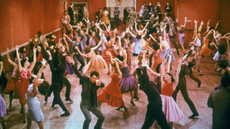The science behind the Strictly Come Dancing curse
Seann Walsh dumped by girlfriend over his kiss with dance partner Katya Jones

The Strictly Come Dancing curse appears to have hit again.
Comedian Seann Walsh and his professional dance partner Katya Jones have issued an apology after photographs emerged showing them kissing during a night out. Walsh described their smooch as a “drunken mistake”, while Jones insisted it was not a reflection of her marriage to fellow Strictly dancer Neil.
Walsh’s girlfriend, Rebecca Humphries, subsequently revealed that the kiss had taken place on her birthday, that she was leaving him and taking the cat.
Subscribe to The Week
Escape your echo chamber. Get the facts behind the news, plus analysis from multiple perspectives.

Sign up for The Week's Free Newsletters
From our morning news briefing to a weekly Good News Newsletter, get the best of The Week delivered directly to your inbox.
From our morning news briefing to a weekly Good News Newsletter, get the best of The Week delivered directly to your inbox.
The funnyman is by no means the first to suffer a relationship split while appearing on the BBC dance show. Several celebrity contestants have ended up dating their dance partner, despite one or both of them being with other people at the start of the series. Most of them denied having an overlapping affair.
Boxer Joe Calzaghe broke up with his girlfriend of five years during the first week of Strictly training in 2009, and later dated his dance partner Kristina Rihanoff for four years. Rihanoff then ended up with rugby star Ben Cohen after they partnered up for the 2013 show.
That same year Countdown mathematician Rachel Riley split from her husband a few months after competing in the dance contest, and later dated her dance partner Pasha Kovalev.
So what is really behind the “curse”?
Dr Peter Lovatt, who leads the Dance Psychology Lab at the University of Hertfordshire, says there are several “scientific reasons” for the trend, including social bonding through the medium of shared movement.
“Even when you have a baby and bounce it in time or out of time with other people, when you bounce it in time the child will afterwards show more pro-social behaviour to those other people,” he told the BBC. “In Strictly, you have this shared movement day after day after day.”
Lovatt says that dance partners even gain a “knowledge of the other person’s state of fertility” as a result of the intimacy of the ballroom and Latin dances, giving them a tight bond, and that partners synchonrise their mood changes according to the different types of dance.
“This will make them feel like a single entity,” he says. “Their emotions are going up and down together, the same emotional rollercoaster.”
Create an account with the same email registered to your subscription to unlock access.
Sign up for Today's Best Articles in your inbox
A free daily email with the biggest news stories of the day – and the best features from TheWeek.com
-
 India elections start amid violence, hate speech accusations
India elections start amid violence, hate speech accusationsTalking Points Narendra Modi seeks a third term while critics worry about the future of the country's democracy
By Joel Mathis, The Week US Published
-
 'Biden is smart to keep the border-security pressure on'
'Biden is smart to keep the border-security pressure on'Instant Opinion Opinion, comment and editorials of the day
By Harold Maass, The Week US Published
-
 Bird flu worries mount as virus found in milk, cows
Bird flu worries mount as virus found in milk, cowsSpeed Read The FDA found traces of the virus in pasteurized grocery store milk
By Peter Weber, The Week US Published
-
 Len Goodman: five things you might not know about the Strictly star
Len Goodman: five things you might not know about the Strictly starWhy Everyone’s Talking About Tributes to the dance show judge pour in following his death at the age of 78
By Keumars Afifi-Sabet Published
-
 Sport on TV guide: Christmas 2022 and New Year listings
Sport on TV guide: Christmas 2022 and New Year listingsSpeed Read Enjoy a feast of sporting action with football, darts, rugby union, racing, NFL and NBA
By Mike Starling Published
-
 House of the Dragon: what to expect from the Game of Thrones prequel
House of the Dragon: what to expect from the Game of Thrones prequelSpeed Read Ten-part series, set 200 years before GoT, will show the incestuous decline of Targaryen
By Chas Newkey-Burden Published
-
 One in 20 young Americans identify as trans or non-binary
One in 20 young Americans identify as trans or non-binarySpeed Read New research suggests that 44% of US adults know someone who is transgender
By The Week Staff Published
-
 The Turner Prize 2022: a ‘vintage’ shortlist?
The Turner Prize 2022: a ‘vintage’ shortlist?Speed Read All four artists look towards ‘growth, revival and reinvention’ in their work
By The Week Staff Last updated
-
 What’s on TV this Christmas? The best holiday television
What’s on TV this Christmas? The best holiday televisionSpeed Read From films and documentaries to musicals for all the family
By The Week Staff Published
-
 Coco vision: up close to Chanel opticals
Coco vision: up close to Chanel opticalsSpeed Read Parisian luxury house adds opticals to digital offering
By The Week Staff Published
-
 Abba returns: how the Swedish supergroup and their ‘Abba-tars’ are taking a chance on a reunion
Abba returns: how the Swedish supergroup and their ‘Abba-tars’ are taking a chance on a reunionSpeed Read From next May, digital avatars of the foursome will be performing concerts in east London
By The Week Staff Published